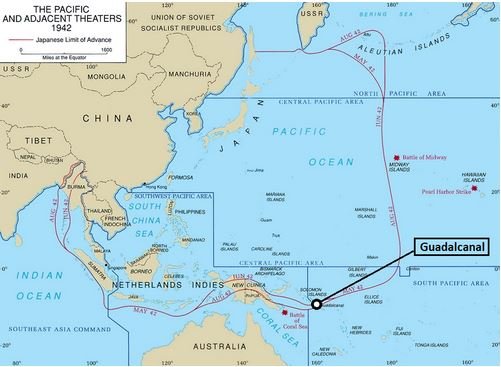By Lawrence Sellin, Li-Meng Yan and Ding-Gang Wang
History does repeat itself.
In 1942, as part of its outer perimeter strategy, Imperial Japan began building an airbase on Guadalcanal in the Solomon Islands.

The purpose of the Guadalcanal airbase was to protect the Japanese naval base in Rabaul, secure Japanese military operations in the Coral Sea and threaten the sea lanes between the United States and Australia using long-range bombers.
In the first major land offensive against Imperial Japan, the United States invaded Guadalcanal on August 7, 1942, finally securing the island in February 1943.
In September 2019, the Solomon Island broke its long-established ties with Taiwan and established diplomatic relations with Beijing, which offered millions of dollars in development aid to replace support from Taiwan.
In April 2022, the Solomon Islands signed a security pact with China, which allows a Chinese military and naval presence on the islands.
Many believe that the Solomon Islands has fallen into a debt-trap, which China frequently uses as a means to force countries to accept Chinese control over their economies and security arrangements.
Reports indicate that the Chinese Communist Party has bribed Solomon Island politicians as an additional method to advance Beijing’s interests in the country.
China’s plans include Huawei building more than 150 telecommunications towers that critics fear could enable Chinese surveillance operations.
On August 30, 2022, the Solomon Islands government announced that it would ban all foreign military ships from docking at its ports, more than a week after requests from a U.S. Coast Guard ship and a British naval vessel went unanswered and months after the Pacific nation signed a defense pact with China.
Although China denies any intent to build a military base in the Solomon Islands calling it “fake news,” sources inside China suggest otherwise.
It is important to note that the Solomon Islands has no military and maintains a police force of about 500 officers.
The China Harbour Engineering Company (CHEC), which operates in the Solomon Islands, has a security force of over 1,000 personnel.
According to the sources inside China, the CHECH security force is composed of People’s Liberation Army Marine Corps members from China’s South Sea Fleet.
There is no question that China is expanding its military presence globally at strategic choke points; in the South China Sea, in Djibouti at the entrance to the Red Sea and the Suez Canal, in Pakistan at the mouth of the Persian Gulf and now in the Solomon Islands at the eastern edge of China’s planned sphere of influence.
A Solomon Islands military base may be one element of Beijing’s effort to create a Chinese version of Imperial Japan’s Greater East Asia Co-Prosperity Sphere, in which Japanese bases in the Solomons were an effort to separate the United States from Australia.
U.S. Marines may again be visiting Guadalcanal.
* * * * * * * * * *
Lawrence Sellin, Ph.D. is retired U.S. Army Reserve colonel and a veteran of Afghanistan and Iraq. He had a civilian career in international business and medical research. Dr. Sellin is the author of Restoring the Republic: Arguments for a Second American Revolution. His email address is lawrence.sellin@gmail.com.
The post The Second Battle of Guadalcanal – This Time China is the Enemy appeared first on The Gateway Pundit.
